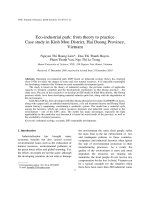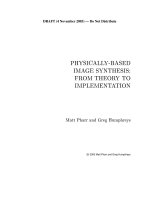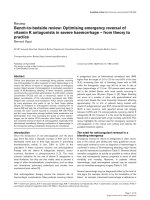lte the umts long taerm evolution from theory to practice 2nd edition
Bạn đang xem bản rút gọn của tài liệu. Xem và tải ngay bản đầy đủ của tài liệu tại đây (7.5 MB, 794 trang )
LTE – The UMTS Long Term Evolution
LTE – The UMTS
Long Term Evolution
From Theory to Practice
Second Edition
Stefania Sesia
ST-Ericsson, France
Issam Toufik
ETSI, France
Matthew Baker
Alcatel-Lucent, UK
A John Wiley & Sons, Ltd., Publicatio
n
This edition first published 2011
© 2011 John Wiley & Sons Ltd.
Registered office
John Wiley & Sons Ltd, The Atrium, Southern Gate, Chichester, West Sussex, PO19 8SQ,
United Kingdom
For details of our global editorial offices, for customer services and for information about how to apply
for permission to reuse the copyright material in this book please see our website at www.wiley.com.
The rights of the authors to be identified as the authors of this work have been asserted in accordance
with the Copyright, Designs and Patents Act 1988.
All rights reserved. No part of this publication may be reproduced, stored in a retrieval system, or
transmitted, in any form or by any means, electronic, mechanical, photocopying, recording or
otherwise, except as permitted by the UK Copyright, Designs and Patents Act 1988, without the prior
permission of the publisher.
Photograph on cover courtesy of Alcatel-Lucent, from the ngConnect LTE-equipped car.
3GPP website reproduced by permission of © 3GPP
TM
.
Wiley also publishes its books in a variety of electronic formats. Some content that appears in print
may not be available in electronic books.
Designations used by companies to distinguish their products are often claimed as trademarks. All
brand names and product names used in this book are trade names, service marks, trademarks or
registered trademarks of their respective owners. The publisher is not associated with any product or
vendor mentioned in this book. This publication is designed to provide accurate and authoritative
information in regard to the subject matter covered. It is sold on the understanding that the publisher is
not engaged in rendering professional services. If professional advice or other expert assistance is
required, the services of a competent professional should be sought.
Library of Congress Cataloging-in-Publication Data
Sesia, Stefania.
p. cm.
Includes bibliographical references and index.
oBook ISBN: 9780470978504
epub ISBN: 9780470978641
Printed in Great Britain by CPI Antony Rowe, Chippenham, Wiltshire.
Print ISBN: 9780470660256 (H/B)
Matthew Baker.
-
2nd ed.
ISBN 978-0-470-66025-6 (hardback)
1. Universal Mobile Telecommunications System. 2. Long-Term Evolution (Telecommunications)
I. Toufik, Issam. II. Baker, Matthew (Matthew P.J.) III. Title.
A catalogue record for this book is available from the British Library.
TK5103.4883.S47 2011
ePDF ISBN: 9780470978511
621.3845 6
-
dc22
2010039466
c
LTE–the UMTS long term evolution : from theory to practice / Stefania Sesia, Issam Toufik,
Dedication
To my family.
Stefania Sesia
To my parents for their sacrifices and unconditional love. To my brother and sisters for their love and
continual support. To my friends for being what they are.
Issam Toufik
To the glory of God, who ‘so loved the world that He gave His only Son, that whoever believes in Him
shall not perish but have eternal life’. — The Bible.
Matthew Baker
Contents
Editors’ Biographies
List of Contributors
Foreword
Preface
Acknowledgements
List of Acronyms
1 Introduction and Background 1
Thomas Sälzer and Matthew Baker
1.1 The Context for the Long Term Evolution of UMTS 1
1.1.1 Historical Context 1
1.1.2 LTE in the Mobile Radio Landscape 2
1.1.3 The Standardization Process in 3GPP 5
1.2 Requirements and Targets for the Long Term Evolution 7
1.2.1 System Performance Requirements 7
1.2.2 Deployment Cost and Interoperability 12
1.3 Technologies for the Long Term Evolution 14
1.3.1 Multicarrier Technology 14
1.3.2 Multiple Antenna Technology 15
1.3.3 Packet-Switched Radio Interface 16
1.3.4 User Equipment Categories 17
1.3.5 From the First LTE Release to LTE-Advanced 19
1.4 From Theory to Practice 20
References 21
xxi
xxiii
xxvii
xxix
xxxi
xxxiii
viii CONTENTS
Part I Network Architecture and Protocols 23
2 Network Architecture 25
Sudeep Palat and Philippe Godin
2.1 Introduction 25
2.2 Overall Architectural Overview 26
2.2.1 The Core Network 27
2.2.2 The Access Network 30
2.2.3 Roaming Architecture 31
2.3 Protocol Architecture 32
2.3.1 User Plane 32
2.3.2 Control Plane 33
2.4 Quality of Service and EPS Bearers 34
2.4.1 Bearer Establishment Procedure 37
2.4.2 Inter-Working with other RATs 38
2.5 The E-UTRAN Network Interfaces: S1 Interface 40
2.5.1 Protocol Structure over S1 41
2.5.2 Initiation over S1 43
2.5.3 Context Management over S1 43
2.5.4 Bearer Management over S1 44
2.5.5 Paging over S1 44
2.5.6 Mobility over S1 45
2.5.7 Load Management over S1 47
2.5.8 Trace Function 48
2.5.9 Delivery of Warning Messages 48
2.6 The E-UTRAN Network Interfaces: X2 Interface 49
2.6.1 Protocol Structure over X2 49
2.6.2 Initiation over X2 49
2.6.3 Mobility over X2 51
2.6.4 Load and Interference Management Over X2 54
2.6.5 UE Historical Information Over X2 54
2.7 Summary 55
References 55
3 Control Plane Protocols 57
Himke van der Velde
3.1 Introduction 57
3.2 Radio Resource Control (RRC) 58
3.2.1 Introduction 58
3.2.2 System Information 59
3.2.3 Connection Control within LTE 63
3.2.4 Connected Mode Inter-RAT Mobility 73
3.2.5 Measurements 75
3.2.6 Other RRC Signalling Aspects 78
3.3 PLMN and Cell Selection 78
CONTENTS ix
3.3.1 Introduction 78
3.3.2 PLMN Selection 79
3.3.3 Cell Selection 79
3.3.4 Cell Reselection 80
3.4 Paging 84
3.5 Summary 86
References 86
4 User Plane Protocols 87
Patrick Fischer, SeungJune Yi, SungDuck Chun and YoungDae Lee
4.1 Introduction to the User Plane Protocol Stack 87
4.2 Packet Data Convergence Protocol (PDCP) 89
4.2.1 Functions and Architecture 89
4.2.2 Header Compression 90
4.2.3 Security 92
4.2.4 Handover 93
4.2.5 Discard of Data Packets 95
4.2.6 PDCP PDU Formats 97
4.3 Radio Link Control (RLC) 98
4.3.1 RLC Entities 99
4.3.2 RLC PDU Formats 105
4.4 Medium Access Control (MAC) 108
4.4.1 MAC Architecture 108
4.4.2 MAC Functions 111
4.5 Summary of the User Plane Protocols 120
References 120
Part II Physical Layer for Downlink 121
5 Orthogonal Frequency Division Multiple Access (OFDMA) 123
Andrea Ancora, Issam Toufik, Andreas Bury and Dirk Slock
5.1 Introduction 123
5.1.1 History of OFDM Development 124
5.2 OFDM 125
5.2.1 Orthogonal Multiplexing Principle 125
5.2.2 Peak-to-Average Power Ratio and Sensitivity to Non-Linearity . . . . 131
5.2.3 Sensitivity to Carrier Frequency Offset and Time-Varying Channels . 133
5.2.4 Timing Offset and Cyclic Prefix Dimensioning 135
5.3 OFDMA 137
5.4 Parameter Dimensioning 139
5.4.1 Physical Layer Parameters for LTE 140
5.5 Summary 142
References 142
x CONTENTS
6 Introduction to Downlink Physical Layer Design 145
Matthew Baker
6.1 Introduction 145
6.2 Transmission Resource Structure 145
6.3 Signal Structure 148
6.4 Introduction to Downlink Operation 149
References 150
7 Synchronization and Cell Search 151
Fabrizio Tomatis and Stefania Sesia
7.1 Introduction 151
7.2 Synchronization Sequences and Cell Search in LTE 151
7.2.1 Zadoff–Chu Sequences 155
7.2.2 Primary Synchronization Signal (PSS) Sequences 157
7.2.3 Secondary Synchronization Signal (SSS) Sequences 158
7.3 Coherent Versus Non-Coherent Detection 161
References 163
8 Reference Signals and Channel Estimation 165
Andrea Ancora, Stefania Sesia and Alex Gorokhov
8.1 Introduction 165
8.2 Design of Reference Signals in the LTE Downlink 167
8.2.1 Cell-Specific Reference Signals 168
8.2.2 UE-Specific Reference Signals in Release 8 171
8.2.3 UE-Specific Reference Signals in Release 9 171
8.3 RS-Aided Channel Modelling and Estimation 174
8.3.1 Time-Frequency-Domain Correlation: The WSSUS Channel Model . 175
8.3.2 Spatial-Domain Correlation: The Kronecker Model 176
8.4 Frequency-Domain Channel Estimation 178
8.4.1 Channel Estimate Interpolation 178
8.4.2 General Approach to Linear Channel Estimation 179
8.4.3 Performance Comparison 180
8.5 Time-Domain Channel Estimation 181
8.5.1 Finite and Infinite Length MMSE 182
8.5.2 Normalized Least-Mean-Square 184
8.6 Spatial-Domain Channel Estimation 184
8.7 Advanced Techniques 185
References 186
9 Downlink Physical Data and Control Channels 189
Matthew Baker and Tim Moulsley
9.1 Introduction 189
9.2 Downlink Data-Transporting Channels 189
9.2.1 Physical Broadcast Channel (PBCH) 189
9.2.2 192Physical Downlink Shared CHannel (PDSCH) . .
CONTENTS xi
9.2.3 Physical Multicast Channel (PMCH) 196
9.3 Downlink Control Channels 196
9.3.1 Requirements for Control Channel Design 196
9.3.2 Control Channel Structure 198
9.3.3 198
9.3.4 Physical Hybrid ARQ Indicator Channel (PHICH) 200
9.3.5 202
9.3.6 PDCCH Scheduling Process 212
References 214
10 Link Adaptation and Channel Coding 215
Brian Classon, Ajit Nimbalker, Stefania Sesia and Issam Toufik
10.1 Introduction 215
10.2 Link Adaptation and CQI Feedback 217
10.2.1 CQI Feedback in LTE 218
10.3 Channel Coding 223
10.3.1 Theoretical Aspects of Channel Coding 223
10.3.2 Channel Coding for Data Channels in LTE 232
10.3.3 Channel Coding for Control Channels in LTE 244
10.4 Conclusions 245
References 246
11 Multiple Antenna Techniques 249
Thomas Sälzer, David Gesbert, Cornelius van Rensburg, Filippo Tosato, Florian
Kaltenberger and Tetsushi Abe
11.1 Fundamentals of Multiple Antenna Theory 249
11.1.1 Overview 249
11.1.2 MIMO Signal Model 252
11.1.3 Single-User MIMO Techniques 253
11.1.4 Multi-User MIMO Techniques 258
11.2 MIMO Schemes in LTE 262
11.2.1 Practical Considerations 263
11.2.2 Single-User Schemes 264
11.2.3 Multi-User MIMO 274
11.2.4 MIMO Performance 276
11.3 Summary 276
References 277
12 Multi-User Scheduling and Interference Coordination 279
Issam Toufik and Raymond Knopp
12.1 Introduction 279
12.2 General Considerations for Resource Allocation Strategies 280
12.3 Scheduling Algorithms 283
12.3.1 Ergodic Capacity 283
12.3.2 Delay-Limited Capacity 285
Physical Control Format Indicator CHannel (PCFICH)
Physical Downlink Control CHannel (PDCCH)
xii CONTENTS
12.4 Considerations for Resource Scheduling in LTE 286
12.5 Interference Coordination and Frequency Reuse 287
12.5.1 Inter-eNodeB Signalling to Support Downlink Frequency-Domain
ICIC in LTE 290
12.5.2 Inter-eNodeB Signalling to Support Uplink Frequency-Domain
ICIC in LTE 290
12.5.3 Static versus Semi-Static ICIC 291
12.6 Summary 291
References 292
13 Broadcast Operation 293
Himke van der Velde, Olivier Hus and Matthew Baker
13.1 Introduction 293
13.2 Broadcast Modes 293
13.3 Overall MBMS Architecture 295
13.3.1 Reference Architecture 295
13.3.2 Content Provision 295
13.3.3 Core Network 296
13.3.4 Radio Access Network – E-UTRAN/UTRAN/GERAN and UE . . . 296
13.3.5 MBMS Interfaces 297
13.4 MBMS Single Frequency Network Transmission 297
13.4.1 Physical Layer Aspects 297
13.4.2 MBSFN Areas 301
13.5 MBMS Characteristics 303
13.5.1 Mobility Support 303
13.5.2 UE Capabilities and Service Prioritization 303
13.6 Radio Access Protocol Architecture and Signalling 304
13.6.1 Protocol Architecture 304
13.6.2 Session Start Signalling 305
13.6.3 Radio Resource Control (RRC) Signalling Aspects 306
13.6.4 Content Synchronization 308
13.6.5 Counting Procedure 310
13.7 Public Warning Systems 312
13.8 Comparison of Mobile Broadcast Modes 312
13.8.1 Delivery by Cellular Networks 312
13.8.2 Delivery by Broadcast Networks 313
13.8.3 Services and Applications 313
References 314
Part III Physical Layer for Uplink 315
14 Uplink Physical Layer Design 317
Robert Love and Vijay Nangia
14.1 Introduction 317
14.2 SC-FDMA Principles 318
CONTENTS xiii
14.2.1 SC-FDMA Transmission Structure 318
14.2.2 Time-Domain Signal Generation 318
14.2.3 Frequency-Domain Signal Generation (DFT-S-OFDM) 320
14.3 SC-FDMA Design in LTE 321
14.3.1 Transmit Processing for LTE 321
14.3.2 SC-FDMA Parameters for LTE 322
14.3.3 d.c. Subcarrier in SC-FDMA 324
14.3.4 Pulse Shaping 324
14.4 Summary 325
References 326
15 Uplink Reference Signals 327
Robert Love and Vijay Nangia
15.1 Introduction 327
15.2 RS Signal Sequence Generation 328
15.2.1 Base RS Sequences and Sequence Grouping 330
15.2.2 Orthogonal RS via Cyclic Time-Shifts of a Base Sequence 330
15.3 Sequence-Group Hopping and Planning 332
15.3.1 Sequence-Group Hopping 332
15.3.2 Sequence-Group Planning 333
15.4 Cyclic Shift Hopping 333
15.5 Demodulation Reference Signals (DM-RS) 335
15.6 Uplink Sounding Reference Signals (SRS) 337
15.6.1 SRS Subframe Configuration and Position 337
15.6.2 Duration and Periodicity of SRS Transmissions 337
15.6.3 SRS Symbol Structure 338
15.7 Summary 340
References 341
16 Uplink Physical Channel Structure 343
Robert Love and Vijay Nangia
16.1 Introduction 343
16.2 Physical Uplink Shared Data Channel Structure 344
16.2.1 Scheduling on PUSCH 345
16.2.2 PUSCH Transport Block Sizes 347
16.3 Uplink Control Channel Design 348
16.3.1 Physical Uplink Control Channel (PUCCH) Structure 348
16.3.2 Types of Control Signalling Information and PUCCH Formats . . . . 352
16.3.3 Channel State Information Transmission on PUCCH (Format 2) . . . 353
16.3.4 Multiplexing of CSI and HARQ ACK/NACK from a UE on PUCCH 355
16.3.5 HARQ ACK/NACK Transmission on PUCCH (Format 1a/1b) 356
16.3.6 Multiplexing of CSI and HARQ ACK/NACK in the Same (Mixed)
PUCCH RB 363
16.3.7 Scheduling Request (SR) Transmission on PUCCH (Format 1) . . . . 363
16.4 Multiplexing of Control Signalling and UL-SCH Data on PUSCH 365
16.5 ACK/NACK Repetition 367
xiv CONTENTS
16.6 Multiple-Antenna Techniques 367
16.6.1 Closed-Loop Switched Antenna Diversity 367
16.6.2 Multi-User ‘Virtual’ MIMO or SDMA 368
16.7 Summary 369
References 369
17 Random Access 371
Pierre Bertrand and Jing Jiang
17.1 Introduction 371
17.2 Random Access Usage and Requirements in LTE 371
17.3 Random Access Procedure 372
17.3.1 Contention-Based Random Access Procedure 373
17.3.2 Contention-Free Random Access Procedure 376
17.4 Physical Random Access Channel Design 376
17.4.1 Multiplexing of PRACH with PUSCH and PUCCH 376
17.4.2 The PRACH Structure 377
17.4.3 Preamble Sequence Theory and Design 385
17.5 PRACH Implementation 396
17.5.1 UE Transmitter 397
17.5.2 eNodeB PRACH Receiver 398
17.6 Time Division Duplex (TDD) PRACH 404
17.6.1 Preamble Format 4 404
17.7 Concluding Remarks 405
References 406
18 Uplink Transmission Procedures 407
Matthew Baker
18.1 Introduction 407
18.2 Uplink Timing Control 407
18.2.1 Overview 407
18.2.2 Timing Advance Procedure 408
18.3 Power Control 411
18.3.1 Overview 411
18.3.2 Detailed Power Control Behaviour 412
18.3.3 UE Power Headroom Reporting 419
18.3.4 Summary of Uplink Power Control Strategies 420
References 420
Part IV Practical Deployment Aspects 421
19 User Equipment Positioning 423
Karri Ranta-aho and Zukang Shen
19.1 Introduction 423
19.2 Assisted Global Navigation Satellite System (A-GNSS) Positioning . . . . . 425
19.3 Observed Time Difference Of Arrival (OTDOA) Positioning 426
CONTENTS xv
19.3.1 Positioning Reference Signals (PRS) 427
19.3.2 OTDOA Performance and Practical Considerations 430
19.4 Cell-ID-based Positioning 431
19.4.1 Basic CID Positioning 431
19.4.2 Enhanced CID Positioning using Round Trip Time and UE Receive
Level Measurements 431
19.4.3 Enhanced CID Positioning using Round Trip Time and Angle of
Arrival 432
19.5 LTE Positioning Protocols 433
19.6 Summary and Future Techniques 435
References 436
20 The Radio Propagation Environment 437
Juha Ylitalo and Tommi Jämsä
20.1 Introduction 437
20.2 SISO and SIMO Channel Models 438
20.2.1 ITU Channel Model 439
20.2.2 3GPP Channel Model 440
20.2.3 Extended ITU Models 440
20.3 MIMO Channel Models 441
20.3.1 SCM Channel Model 442
20.3.2 SCM-Extension Channel Model 444
20.3.3 WINNER Model 445
20.3.4 LTE Evaluation Model 446
20.3.5 Extended ITU Models with Spatial Correlation 448
20.3.6 ITU Channel Models for IMT-Advanced 449
20.3.7 Comparison of MIMO Channel Models 453
20.4 Radio Channel Implementation for Conformance Testing 454
20.4.1 Performance and Conformance Testing 454
20.4.2 Future Testing Challenges 454
20.5 Concluding Remarks 455
References 455
21 Radio Frequency Aspects 457
Moray Rumney, Takaharu Nakamura, Stefania Sesia, Tony Sayers and Adrian Payne
21.1 Introduction 457
21.2 Frequency Bands and Arrangements 459
21.3 Transmitter RF Requirements 462
21.3.1 Requirements for the Intended Transmissions 462
21.3.2 Requirements for Unwanted Emissions 467
21.3.3 Power Amplifier Considerations 471
21.4 Receiver RF Requirements 474
21.4.1 Receiver General Requirements 474
21.4.2 Transmit Signal Leakage 475
21.4.3 Maximum Input Level 477
21.4.4 Small Signal Requirements 478
xvi CONTENTS
21.4.5 Selectivity and Blocking Specifications 482
21.4.6 Spurious Emissions 488
21.4.7 Intermodulation Requirements 489
21.4.8 Dynamic Range 491
21.5 RF Impairments 492
21.5.1 Transmitter RF Impairments 492
21.5.2 Model of the Main RF Impairments 495
21.6 Summary 500
References 501
22 Radio Resource Management 503
Muhammad Kazmi
22.1 Introduction 503
22.2 Cell Search Performance 505
22.2.1 Cell Search within E-UTRAN 505
22.2.2 E-UTRAN to E-UTRAN Cell Global Identifier Reporting
Requirements 509
22.2.3 E-UTRAN to UTRAN Cell Search 510
22.2.4 E-UTRAN to GSM Cell Search 511
22.2.5 Enhanced Inter-RAT Measurement Requirements 512
22.3 Mobility Measurements 513
22.3.1 E-UTRAN Measurements 513
22.3.2 UTRAN Measurements 514
22.3.3 GSM Measurements: GSM Carrier RSSI 516
22.3.4 CDMA2000 Measurements 516
22.4 UE Measurement Reporting Mechanisms and Requirements 516
22.4.1 E-UTRAN Event Triggered Reporting Requirements 517
22.4.2 Inter-RAT Event-Triggered Reporting 517
22.5 Mobility Performance 518
22.5.1 Mobility Performance in RRC_IDLE State 518
22.5.2 Mobility Performance in RRC_CONNECTED State 522
22.6 RRC Connection Mobility Control Performance 525
22.6.1 RRC Connection Re-establishment 525
22.6.2 Random Access 525
22.7 Radio Link Monitoring Performance 526
22.7.1 In-sync and Out-of-sync Thresholds 526
22.7.2 Requirements without DRX 527
22.7.3 Requirements with DRX 527
22.7.4 Requirements during Transitions 527
22.8 Concluding Remarks 528
References 529
23 Paired and Unpaired Spectrum 531
Nicholas Anderson
23.1 Introduction 531
23.2 Duplex Modes 532
CONTENTS xvii
23.3 Interference Issues in Unpaired Spectrum 533
23.3.1 Adjacent Carrier Interference Scenarios 535
23.3.2 Summary of Interference Scenarios 543
23.4 Half-Duplex System Design Aspects 544
23.4.1 Accommodation of Transmit–Receive Switching 544
23.4.2 Coexistence between Dissimilar Systems 547
23.4.3 HARQ and Control Signalling for TDD Operation 548
23.4.4 Half-Duplex FDD (HD-FDD) Physical Layer Operation 551
23.5 Reciprocity 552
23.5.1 Conditions for Reciprocity 554
23.5.2 Applications of Reciprocity 558
23.5.3 Summary of Reciprocity Considerations 561
References 562
24 Picocells, Femtocells and Home eNodeBs 563
Philippe Godin and Nick Whinnett
24.1 Introduction 563
24.2 Home eNodeB Architecture 564
24.2.1 Architecture Overview 564
24.2.2 Functionalities 565
24.2.3 Mobility 566
24.2.4 Local IP Access Support 568
24.3 Interference Management for Femtocell Deployment 569
24.3.1 Interference Scenarios 570
24.3.2 Network Listen Mode 574
24.4 RF Requirements for Small Cells 574
24.4.1 Transmitter Specifications 575
24.4.2 Receiver Specifications 576
24.4.3 Demodulation Performance Requirements 578
24.4.4 Time Synchronization for TDD Operation 579
24.5 Summary 580
References 580
25 Self-Optimizing Networks 581
Philippe Godin
25.1 Introduction 581
25.2 Automatic Neighbour Relation Function (ANRF) 582
25.2.1 Intra-LTE ANRF 582
25.2.2 Automatic Neighbour Relation Table 583
25.2.3 Inter-RAT or Inter-Frequency ANRF 583
25.3 Self-Configuration of eNodeB and MME 584
25.3.1 Self-Configuration of eNodeB/MMEoverS1 585
25.3.2 Self-Configuration of IP address and X2 interface 585
25.4 Automatic Configuration of Physical Cell Identity 587
25.5 Mobility Load Balancing Optimization 587
xviii CONTENTS
25.5.1 Intra-LTE Load Exchange 588
25.5.2 Intra-LTE Handover Parameter Optimization 589
25.5.3 Inter-RAT Load Exchange 590
25.5.4 Enhanced Inter-RAT Load Exchange 590
25.6 Mobility Robustness Optimization 591
25.6.1 Too-Late Handover 591
25.6.2 Coverage Hole Detection 591
25.6.3 Too-Early Handover 592
25.6.4 Handover to an Inappropriate Cell 592
25.6.5 MRO Verdict Improvement 593
25.6.6 Handover to an Unprepared Cell 594
25.6.7 Unnecessary Inter-RAT Handovers 594
25.6.8 Potential Remedies for Identified Mobility Problems 595
25.7 Random Access CHannel (RACH) Self-Optimization 595
25.8 Energy Saving 596
25.9 Emerging New SON Use Cases 597
References 598
26 LTE System Performance 599
Tetsushi Abe
26.1 Introduction 599
26.2 Factors Contributing to LTE System Capacity 599
26.2.1 Multiple Access Techniques 600
26.2.2 Frequency Reuse and Interference Management 600
26.2.3 Multiple Antenna Techniques 601
26.2.4 Semi-Persistent Scheduling 601
26.2.5 Short Subframe Duration and Low HARQ Round Trip Time . 602
26.2.6 Advanced Receivers 602
26.2.7 Layer 1 and Layer 2 Overhead 602
26.3 LTE Capacity Evaluation 603
26.3.1 Downlink and Uplink Spectral Efficiency 605
26.3.2 VoIP Capacity 608
26.4 LTE Coverage and Link Budget 608
26.5 Summary 610
References 611
Part V LTE-Advanced 613
27 Introduction to LTE-Advanced 615
Dirk Gerstenberger
27.1 Introduction and Requirements 615
27.2 Overview of the Main Features of LTE-Advanced 618
27.3 Backward Compatibility 619
27.4 Deployment Aspects 620
27.5 UE Categories for LTE-Advanced 621
CONTENTS xix
References 622
28 Carrier Aggregation 623
Juan Montojo and Jelena Damnjanovic
28.1 Introduction 623
28.2 Protocols for Carrier Aggregation 624
28.2.1 Initial Acquisition, Connection Establishment and CC Management . 624
28.2.2 Measurements and Mobility 625
28.2.3 User Plane Protocols 628
28.3 Physical Layer Aspects 631
28.3.1 Downlink Control Signalling 631
28.3.2 Uplink Control Signalling 636
28.3.3 Sounding Reference Signals 642
28.3.4 Uplink Timing Advance 642
28.3.5 Uplink Power Control 642
28.3.6 Uplink Multiple Access Scheme Enhancements 644
28.4 UE Transmitter and Receiver Aspects 648
28.4.1 UE Transmitter Aspects of Carrier Aggregation 648
28.4.2 UE Receiver Aspects of Carrier Aggregation 648
28.4.3 Prioritized Carrier Aggregation Scenarios 649
28.5 Summary 650
References 650
29 Multiple Antenna Techniques for LTE-Advanced 651
Alex Gorokhov, Amir Farajidana, Kapil Bhattad, Xiliang Luo and Stefan Geirhofer
29.1 Downlink Reference Signals 651
29.1.1 Downlink Reference Signals for Demodulation 652
29.1.2 Downlink Reference Signals for Estimation of Channel State
Information (CSI-RS) 654
29.2 Uplink Reference Signals 657
29.2.1 Uplink DeModulation Reference Signals (DM-RS) 657
29.2.2 Sounding Reference Signals (SRSs) 658
29.3 Downlink MIMO Enhancements 659
29.3.1 Downlink 8-Antenna Transmission 659
29.3.2 Enhanced Downlink Multi-User MIMO 661
29.3.3 Enhanced CSI Feedback 662
29.4 Uplink Multiple Antenna Transmission 666
29.4.1 Uplink SU-MIMO for PUSCH 666
29.4.2 Uplink Transmit Diversity for PUCCH 668
29.5 Coordinated MultiPoint (CoMP) Transmission and Reception 669
29.5.1 Cooperative MIMO Schemes and Scenarios 669
29.6 Summary 671
References 671
xx CONTENTS
30 Relaying 673
Eric Hardouin, J. Nicholas Laneman,
Alexander Golitschek, Hidetoshi Suzuki, Osvaldo Gonsa
30.1 Introduction 673
30.1.1 What is Relaying? 673
30.1.2 Characteristics of Relay Nodes 675
30.1.3 Protocol Functionality of Relay Nodes 676
30.1.4 Relevant Deployment Scenarios 677
30.2 Theoretical Analysis of Relaying 679
30.2.1 Relaying Strategies and Benefits 679
30.2.2 Duplex Constraints and Resource Allocation 683
30.3 Relay Nodes in LTE-Advanced 684
30.3.1 Types of RN 684
30.3.2 Backhaul and Access Resource Sharing 685
30.3.3 Relay Architecture 687
30.3.4 RN Initialization and Configuration 689
30.3.5 Random Access on the Backhaul Link 690
30.3.6 Radio Link Failure on the Backhaul Link 690
30.3.7 RN Security 690
30.3.8 Backhaul Physical Channels 691
30.3.9 Backhaul Scheduling 696
30.3.10 Backhaul HARQ 698
30.4 Summary 699
References 699
31 Additional Features of LTE Release 10 701
Teck Hu, Philippe Godin and Sudeep Palat
31.1 Introduction 701
31.2 Enhanced Inter-Cell Interference Coordination 701
31.2.1 LTE Interference Management 703
31.2.2 Almost Blank Subframes 703
31.2.3 X2 Interface Enhancements for Time-Domain ICIC 705
31.2.4 UE Measurements in Time-Domain ICIC Scenarios 706
31.2.5 RRC Signalling for Restricted Measurements 708
31.2.6 ABS Deployment Considerations 709
31.3 Minimization of Drive Tests 710
31.3.1 Logged MDT 711
31.3.2 Immediate MDT 712
31.4 Machine-Type Communications 712
References 714
32 LTE-Advanced Performance and Future Developments 715
Takehiro Nakamura and Tetsushi Abe
32.1 LTE-Advanced System Performance 715
32.2 Future Developments 718
References 720
Index 721
Editors’ Biographies
Matthew Baker holds degrees in Engineering and Electrical and Information Sciences
from the University of Cambridge. From 1996 to 2009 he worked at Philips Research
where he conducted leading-edge research into a variety of wireless communication systems
and techniques, including propagation modelling, DECT, Hiperlan and UMTS, as well as
leading the Philips RAN standardization team. He has been actively participating in the
standardization of both UMTS WCDMA and LTE in 3GPP since 1999, where he has been
active in 3GPP TSG RAN Working Groups 1, 2, 4 and 5, contributing several hundred
proposals. He now works for Alcatel-Lucent, which he joined in 2009, and he has been
Chairman of 3GPP TSG RAN Working Group 1 since being elected to the post in August
of that year. He is the author of several international conference papers and inventor of
numerous patents. He is a Chartered Engineer, a Member of the Institution of Engineering
and Technology and a Visiting Lecturer at the University of Reading, UK.
Stefania Sesia received her Ph.D. degree in Communication Systems and Coding Theory
from both Eurecom (Sophia Antipolis, France) and ENST-Paris (Paris, France) in 2005. From
2002 to 2005 she worked at Motorola Research Labs, Paris, towards her Ph.D. thesis. In June
2005 she joined Philips/NXP Semiconductors (now ST-Ericsson) Research and Development
Centre in Sophia Antipolis, France where she was technical leader and responsible for the
High Speed Downlink Packet Access algorithm development. She has been participating in
3GPP TSG RAN Working Groups 1 and 4 standardization meetings. From 2007 to 2009
she was on secondment from NXP Semiconductors to the European Telecommunications
Standard Institute (ETSI) acting as 3GPP TSG RAN and 3GPP TSG RAN Working Group 4
Technical Officer. She is currently back in ST-Ericsson as senior research and development
engineer, actively participating in 3GPP TSG RAN Working Group 4 as a delegate. She is the
author of several international IEEE conference and journal papers and many contributions
to 3GPP, and inventor of numerous US and European patents.
Issam Toufik graduated in Telecommunications Engineering (majoring in Mobile Commu-
nication Systems) in 2002 from both ENST-Bretagne (Brest, France) and Eurecom (Sophia
Antipolis, France). In 2006, he received his Ph.D. degree in Communication Systems from
Eurecom/ENST-Paris, France. From June to August 2005 he worked for Samsung Advanced
Institute of Technology (SAIT), South Korea, as a Research Engineer on LTE. In January
2007, he joined NXP Semiconductors/ST-Ericsson, Sophia Antipolis, France, as a Research
and Development Engineer for UMTS and LTE algorithm development. In November 2009,
he joined the European Telecommunications Standard Institute (ETSI) acting as 3GPP TSG
EDITORS’ BIOGRAPHIES
RAN and 3GPP TSG RAN Working Group 4 Technical Officer. He is the author of several
international IEEE conference and journal papers and contributions to 3GPP, and inventor of
numerous patents.
xxii
List of Contributors
Abe, Tetsushi, NTT DOCOMO
e-mail:
Ancora, Andrea, ST-Ericsson
e-mail:
Anderson, Nicholas, Research In Motion
e-mail:
Baker, Matthew, Alcatel-Lucent
e-mail: ,
Bertrand, Pierre, Texas Instruments
e-mail:
Bhattad, Kapil, Qualcomm
e-mail:
Bury, Andreas, Blue Wonder Communications
e-mail:
Chun, SungDuck,LG Electronics
e-mail:
Classon, Brian, Huawei
e-mail:
Damnjanovic, Jelena, Qualcomm
e-mail:
Farajidana, Amir, Qualcomm
e-mail:
Fischer, Patrick, Bouygues Telecom
e-mail: pfi
Geirhofer, Stefan, Qualcomm
e-mail:
Gerstenberger, Dirk, Ericsson
e-mail:
Gesbert, David, Eurecom
e-mail:
Godin, Philippe, Alcatel-Lucent
e-mail:









